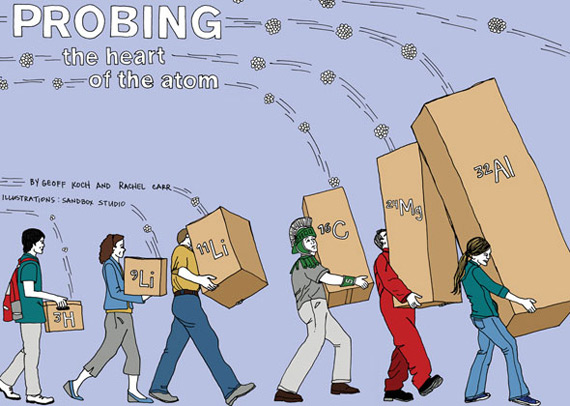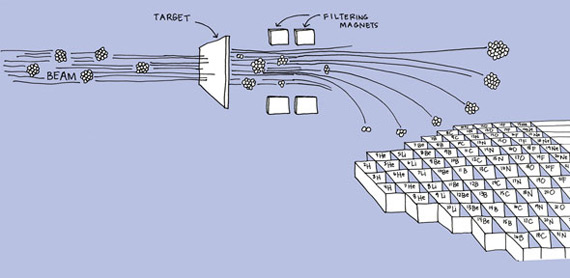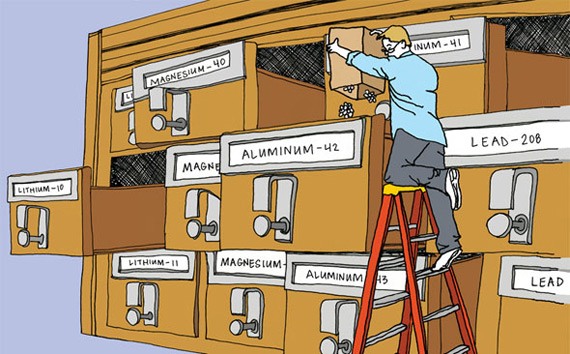Probing the heart of the atom
The familiar elements of the Periodic Table come in a number of forms, or isotopessome found only fleetingly in the most violent events, such as exploding stars. By creating those rare isotopes in the lab, physicists are learning how the atomic nucleus works and deciphering the natural history of the elements.
By Geoff Koch and Rachel Carr
Illustrations by Sandbox Studios
 |
Andreas Stolz has a problem. Because of advances in superconducting magnet technology, the Michigan State University assistant professor desperately needs a new metaphor to describe the process he and his international collaborators use to create and isolate exotic nuclei.
Stolz is a physicist at MSUs National Superconducting Cyclotron Laboratory, or NSCL, one of a handful of facilities worldwide that produce rare isotopes using fast-beam fragmentation. Heres how it works: Scientists accelerate a beam of stable, ionized nuclei to nearly half the speed of light and slam it into a thin metal target. The resulting spray of reaction products continues down the beamline, where a network of magnets separates a few sought-after rare isotopes from the rest of the nuclear chaff. This cutting-edge technology helps scientists probe deeper than ever before into the origins and properties of the atoms core.
Its the increasing precision of the filtering magnets thats giving Stolz some grief as he attempts to explain his work.
"I used to compare the filtering done by the magnets to finding one person out of all the several billion people on Earth," says Stolz, who has worked as an experimental physicist since the mid 1990s. "Now it would be more like finding one person on a billion Earths, a scenario thats nearly impossible to imagine."

Advances in fast-beam fragmentation are transforming nuclear science. A generation ago, researchers were relegated to studying the few hundred nuclei that exist naturally on Earth or were relatively easy to create in the laboratory. Today, scientists at NSCL and around the world have thousands of nuclei at their disposal, including the most tantalizing prizes of allrare, fleeting isotopes that otherwise exist only in extreme environments, such as exploding stars.
NSCL is the nations largest university-based nuclear science laboratory and one of three flagship facilities in the United States. The others are Thomas Jefferson National Accelerator Facility in Virginia and Brookhaven National Laboratorys Relativistic Heavy Ion Collider in New York. RHICs PHENIX and STAR detectors study the so-called quark-gluon plasma that may have made up the universe shortly after the big bang, complementing the work of fast-beam fragmentation facilities like the one at Michigan State.
Stolz and his colleagues at the MSU lab have produced more than 600 rare isotopes during the past seven years. These exotic nuclei, with their unusual numbers of proton and neutron constituents, are critically important to nuclear physicists and chemists who are attempting to decipher the natural history of the chemical elements.

That history is pockmarked with gaps and a slew of seemingly basic unanswered questions: How are elements heavier than iron created? Why is there a difference between the predicted and observed abundance of elements? What is the precise nature of ultra-dense neutron stars, which astronomers know to be among the brightest sources of X-rays in the universe? On an even larger scale, what are the origin, evolution, and structure of visible matter in the cosmos?
"Nuclear physics, in general, tells us about so many different processes," says Barbara Jacak, a physicist at Stony Brook University in New York and contributor to the PHENIX studies. "Its there from the first microsecond of the big bang all the way to reactions that are taking place in supernovae right now."
By focusing on the miniature world of the nucleus, scientists bring a unique perspective to the picture other branches of physics sketch out.
"Particle physicists tend to be reductioniststhey seek the truth in the smallest pieces," says Wolfgang Bauer, chair of MSUs physics and astronomy department. "Nuclear physicists focus on how those small pieces are organized in bigger systems. And astrophysicists can use their findings to study even larger systems. We need all three viewpoints to answer the most interesting questions."
For now, the nuclear scale is proving enigmatic enough.

Since its genesis in the early twentieth century, nuclear physics has made key contributions to our understanding of matter. But researchers continue to make revolutionary finds. For instance, a decade ago most nuclear physics textbooks described the shapes of nuclei as more or less similar to undifferentiated spherical drops of liquid. Now those textbooks are obsolete. It turns out that nuclei can resemble everything from spheres to pancakes to cigars, a discovery that stemmed from the study of rare isotopes produced by fast-beam fragmentation facilities.
Another surprise concerns the basic rule governing the size of nuclei.
"For a long time, we thought that the fundamental size of a nucleus depends on its number of protons and neutrons," says physicist Brad Sherrill, associate director of research at NSCL. "But then came lithium-11."
In 1985, Japanese researchers discovered that lithium-11, with just three protons and eight neutrons, occupied the same amount of space as lead-208, which has 82 protons and 126 neutrons. The reason is that two neutrons in lithium-11 occupy an outer orbit well beyond the rest.
Unraveling such puzzles, which requires heady amounts of quantum mechanics, is relevant to more than models of stellar evolution.
Sherrill notes that in nanotechnology, engineers are already trying to imagine technologies based on small handfuls of atoms, adding, "Understanding small, nucleus-scale quantum mechanical systems is critical to actually building these technologies and making them work."
 |
| Atomic nuclei come in many varieties, called isotopes. They are labeled according to the number of protons and neutrons inside each nucleus. To create isotopes, scientists smash a beam of nuclei into a thin metal target, which leads to a spray of new particles. Magnets filter the beam and separate the sought-after isotopes from the rest of the nuclear chaff. |

Basic research in nuclear science underpins applied work in nuclear medicine, nuclear energy, and national security. However, much of the work in the worlds fast-beam fragmentation facilities is done in the spirit of blue-sky inquiry: Of all the combinations of protons and neutrons scientists can dream up, which ones can actually stick together, however briefly, and exist as nuclei?
Magnesium-24, with 12 protons and 12 neutrons, exists; in fact, it is the most abundant magnesium isotope. If youre determined, you can dig around the Earths crust and find magnesium-25 and -26, with 13 and 14 neutrons, respectively. But what about magnesium-40, with a whopping 28 neutrons?
That question motivated a recent experiment at NSCL. MSU doctoral student Matt Amthor helped assemble a new set of detectors for the fastbeam fragmentation facility. The team also jury-rigged a way to filter and purify the debris from the collisions twiceone of the first times this two-stage process has ever been used. The goal was to tune the facility to seek out neutron-rich isotopes, produced in fewer than one in a million billion reactions at the target.
After searching for more than a week, Amthor and his collaborators spotted three first-ever magnesium-40 nuclei, along with the similarly novel aluminum-42 and -43. The result was a fall 2007 paper in the journal Nature and subsequent media coverage around the world, attention that may have given Amthor a modest boost as he neared completion of his PhD and searched for postdoctoral research opportunities.
The soft-spoken Amthor from small-town Georgia says he has had a good experience at NSCL, which helps to train 10 percent of all US nuclear-science doctoral students. Scouting the job market, he found a postdoctoral research position at GANIL, a nuclear science facility in northern France, which was seeking PhDs with expertise in ion optics, one of his specialties. Significant upgrades of nuclear science facilities in Germany and Japan are under way, as well. However, in the long run he would like to build his career closer to home and is hopeful that additional investments will be made soon to bolster US nuclear science and education.
"The ideal professional situation would be if we build a next-generation accelerator for rare isotope beams in the United States," Amthor says. "Then I could work there."
On December 11, it became much more likely Amthor would get his wish. That was the day the Department of Energy announced that MSU will be the site of the new $550 million Facility for Rare Isotope Beams, or FRIB, with operations commencing in the middle of the next decade. An experiment that would take a year to run at NSCL might take a week or less at the new facility, making FRIBs powerful new linear accelerator an experimental game-changer.

Investments made in FRIB and other facilities around the world will no doubt rocket accelerator-based physics to still more dizzying levels of precision. Even a billion Earths might be too few, allegorically speaking.
"Nuclear and particle physics do pursue different things, but there are places where they overlap," says Hendrik Weerts, director of the High Energy Physics Division of Argonne National Lab and a professor of physics and astronomy at MSU. "If we find a really underlying symmetry or property of matter, we should be able to see it in both systems."
 |
In the meantime, scientists continue to create and explore the most exotic nuclei, a task that requires ongoing innovation in filtering and purifying the particle debris produced in fast-beam facilities like NSCL.
After more than two years of work, NSCL senior physicist Daniel Bazin is putting the finishing touches on his own contribution to the beam filtering efforta copper-plated radio frequency fragment separator. The device cuts unwanted nuclei out of proton-rich isotope beams, a feat the regular magnets cant easily handle. Its helping researchers and users isolate proton-rich nuclei, which may hold the key to understanding astrophysical phenomena such as spectacular X-ray bursts and the rapid proton-capture process that takes place inside stars and helps to create new elements.
Building the device, which is funded by the National Science Foundation and MSU, hasnt been easy. Bazin has spent long hours doing everything from troubleshooting squirrelly electronics to searching for a company to plate the water heater-sized separator with highly conductive copper.
Not that hes complaining.
"Being able to work across domains is one of the best things about nuclear science," Bazin says. "Of course I get to do physics, which I like, but I also get to do other, more technical tasks that I enjoy, like programming computers and building detectors and electronics systems."
Stolz, who is a co-author on the Nature paper, shares that sentiment, and has his own way of describing his efforts to squeeze the most science out of the labs twin superconducting cyclotrons.
"Its so gratifying to take up the challenge, the fight with nature, even though on a lot of days you lose at the beginning," he says. "The trick is not to give up. You might go home for five days straight with nothing having worked out. But when, on the sixth day, youre successful, that beats all other feelings."
Click here to download the pdf version of this article.






